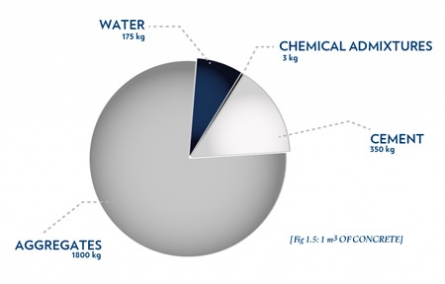Mix Design
The approximate formulation of 1 m3 of concrete is reported in Figure, but of course it may vary depending on the specific characteristics of the materials used (e.g. shape, density and grain size distribution of aggregates) and on the specific performance required to concrete (workability, strength, etc.). For this reason, when a new concrete formulation must be set-up, mix design methods can be very helpful.
Starting from the characteristics of the single components (cement, aggregates, etc.) and the desired characteristics of the final concrete, these methods allow to outline an approximate concrete receipt.
Measuring Materials
For the manufacturing of a good quality structural concrete, the amount of the single components must be measured with suitable accuracy. Materials can be measured by mass or (according to some standards) by volume. National and international standards fix the tolerances to be respected in the measurement of cement, water, aggregates and chemical admixtures. The moisture of aggregates must be taken into account too.
The measured materials are poured into mixers: no charging order is given by standards.
Mixing
Mixing must be efficient, i.e. give a homogeneous material in reasonably short time. A too prolonged mixing may lead to several problems, such as air entraining (and, hence, strength decrease). Moreover, mixing cannot delay setting, as hydration nevertheless occurs: conversely it might destroy the newly formed hydrated compounds. During too prolonged mixing, water is always added in order to maintain some fluidity, but it is extremely harmful for final compressive strength.
Mixers are usually divided into stationary mixers (pan-mixers, etc.), which can provide a good homogeneity in about 1 minute, and truck mixers. All of them must be capable to combine ingredients of the concrete into a thoroughly mixed and uniform mass. Agitators are instead equipments that maintain the plastic concrete in a mixed state up to casting and can be truck mixer or truck agitators.
The efficiency of any mixer or agitator can be experimentally determined: standards suggest testing methods for appraising the concrete homogeneity and the necessary time to have an homogeneous mix.
Casting and Curing
Concrete is usually cast in formwork, strong enough to withstand the pressure of fresh concrete (especially for self compacting concrete, see 11), locked enough to prevent the leakage of cement past, easily positioned and detachable. Fresh concrete should not be poured in formwork from high level but should be cast as near as possible to its final position, to avoid components segregation.
Ordinary concrete should always be compacted by vibration after casting, mainly to ensure the escape of unnecessary trapped air. Fresh concrete must be cured to ensure correct hydration and hardening.





